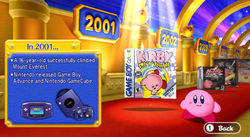Kirby's History: Difference between revisions
m (→Regional differences: The screenshots aren't difference between regions) |
(Overhauled the page) Tag: Disambiguation links |
||
| Line 1: | Line 1: | ||
{{about|the menu in [[Kirby's Dream Collection Special Edition]]|an overview of Kirby's history on WiKirby|[[Kirby]]}} | {{about|the menu in [[Kirby's Dream Collection Special Edition]]|an overview of Kirby's history on WiKirby|[[Kirby]]}} | ||
[[File:KDCSE history menu.png|thumb|250px|A portion of '''Kirby's History''', represented as a long hallway that Kirby runs up and down.]] | [[File:KDCSE history menu.png|thumb|250px|A portion of '''Kirby's History''', represented as a long hallway that Kirby runs up and down.]] | ||
| Line 15: | Line 14: | ||
The music that plays in this hallway is a re-orchestrated medley of the [[Castle Lololo (theme)|Castle Lololo theme]] and the [[Cloudy Park (theme from Kirby's Dream Land 2)|Cloudy Park theme]] from ''[[Kirby's Dream Land 2]]''. This particular arrangement would appear again as the theme for the [[Game Over|Continue]] screen in ''[[Kirby: Triple Deluxe]]'', the normal credits theme for ''[[Kirby Fighters Deluxe]]'' and as the results music for [[Team Kirby Clash]] in ''[[Kirby: Planet Robobot]]''. When selecting an item in the hall, the music that plays in that item's sub-menu will persist after returning to the hall until another item is chosen. | The music that plays in this hallway is a re-orchestrated medley of the [[Castle Lololo (theme)|Castle Lololo theme]] and the [[Cloudy Park (theme from Kirby's Dream Land 2)|Cloudy Park theme]] from ''[[Kirby's Dream Land 2]]''. This particular arrangement would appear again as the theme for the [[Game Over|Continue]] screen in ''[[Kirby: Triple Deluxe]]'', the normal credits theme for ''[[Kirby Fighters Deluxe]]'' and as the results music for [[Team Kirby Clash]] in ''[[Kirby: Planet Robobot]]''. When selecting an item in the hall, the music that plays in that item's sub-menu will persist after returning to the hall until another item is chosen. | ||
== Years == | ==Years== | ||
Listed below are the years with associated stops in the Kirby's History hallway, ranging from pre-1992 to 2012. This list focuses on the North American release of ''Kirby's Dream Collection'', with Japanese regional differences mentioned in the 'Regional differences' sections. | |||
{| class="wikitable | ===~1991=== | ||
~1991 refers to the years before the release of the first ''Kirby'' game, ''Kirby's Dream Land'', in 1992. This stop, which is only present in the Japanese version of ''Kirby's Dream Collection'', displays a golden statue of Kirby. In the North American version of the game, the Kirby's History hallway instead begins at the 1992 stop. | |||
===1992=== | |||
{| class="wikitable" border="1" cellpadding="2" align="right" | |||
!In | |||
!width=350px|In-game blurb<br> | |||
|- | |- | ||
| | | | ||
'''In 1992...'''<br> | |||
*''The [[wikipedia:Summer Olympic Games|Summer Olympic Games]] were held in [[wikipedia:Barcelona|Barcelona]], [[wikipedia:Spain|Spain]].'' | *''The [[wikipedia:Summer Olympic Games|Summer Olympic Games]] were held in [[wikipedia:Barcelona|Barcelona]], [[wikipedia:Spain|Spain]].'' | ||
*''[[wikipedia:Space Shuttle|Space Shuttle]] [[wikipedia:Space Shuttle Endeavour|Endeavour]] made its maiden voyage.'' | *''[[wikipedia:Space Shuttle|Space Shuttle]] [[wikipedia:Space Shuttle Endeavour|Endeavour]] made its maiden voyage.'' | ||
*''[[wikipedia:Bill Clinton|Bill Clinton]] was elected President of the [[wikipedia:United States|USA]].'' | *''[[wikipedia:Bill Clinton|Bill Clinton]] was elected President of the [[wikipedia:United States|USA]].'' | ||
|} | |||
{| class="wikitable" border="1" cellpadding="2" width="60%" | |||
!colspan=3|''[[Kirby's Dream Land]]'' | |||
|- | |||
!rowspan=2|[[File:KDL Box.jpg|170px]] | |||
|'''Select description:''' | |||
|''Kirby's first game! With simple mechanics and friendly worlds, it was a perfect starting point for action-game beginners.'' | |||
|- | |||
|'''Video description:''' | |||
|''The simplicity of Kirby's [[inhale]]/[[Star Bullet|spit]] attack and Kirby's ability to [[Hover|fly]] over obstacles made this a perfect game for beginners. It introduced many of the [[Enemy|enemies]] and [[Item|power-ups]] that are now so familiar to Kirby's fans. It also introduced a [[character]] who would often be Kirby's star opponent: [[King Dedede]]!'' | |||
|- | |||
!Theme music | |||
|colspan=2|[[Welcome to Dream Land]] | |||
|- | |||
!Regional differences | |||
|colspan=2|In the Japanese release, this stop includes the first volume of an official Kirby manga series which released that year, [[Kirby of the Stars (manga by Yoshiko Sakuma)|''Kirby of the Stars'' by Yoshiko Sakuma]]. The player can preview the cover of the manga as well as its first five pages. | |||
|} | |||
===1993=== | |||
{| class="wikitable" border="1" cellpadding="2" align="right" | |||
!width=350px|In-game blurb<br> | |||
|- | |||
| | | | ||
'''In 1993...'''<br> | |||
*''The [[wikipedia: European Union|European Union]] was founded.'' | |||
*''[[wikipedia: Intel|Intel]] released the first [[wikipedia: Pentium (original)|Pentium processor]].'' | |||
*''[[wikipedia: Janet Reno|Janet Reno]] became the first female [[wikipedia: Attorney General|Attorney General]] of the USA.'' | |||
|} | |||
{| class="wikitable" border="1" cellpadding="2" width="60%" | |||
!colspan=3|''[[Kirby's Adventure]]'' | |||
|- | |||
!rowspan=2|[[File:KA Box.jpg|170px]] | |||
|'''Select description:''' | |||
|''This was the first game in the [[Kirby (series)|Kirby series]] to include [[Copy Ability|Copy Abilities]] and [[Sub-Game|minigames]].'' | |||
|- | |||
|'''Video description:''' | |||
|''In this game, players were introduced to Kirby's famous Copy Abilities. Kirby could get 24 different Copy Abilities in this game, including [[Sword]], [[Cutter]], [[Hammer]], [[Spark]], [[Stone]], and [[Parasol]]. This gave players a wide range of new moves to play with and made it possible to play each stage in many ways. Kirby's Adventure was also the first game in the Kirby series to include minigames!'' | |||
|- | |||
!Theme music | |||
|colspan=2|[[Vegetable Valley (theme)|Vegetable Valley]] | |||
|- | |||
|} | |||
{| class="wikitable" border="1" cellpadding="2" width="60%" | |||
!colspan=3|''[[Kirby's Pinball Land]]'' | |||
|- | |||
!rowspan=2|[[File:KPL Box.png|170px]] | |||
|'''Select description:''' | |||
|''A game in which ball-shaped Kirby had to reach, and then beat, bosses waiting at the top of exciting pinball stages.'' | |||
|- | |||
|'''Video description:''' | |||
|''In this game, the first to veer from Kirby's traditional platforming roots, players helped Kirby explore three challenging pinball worlds by flipping Kirby's bouncy, ball-shaped body. Exciting traps, bonus games, and enemies filled each [[Kirby's Pinball Land#Pinball Lands|world]]. To beat the game, players had to help Kirby defeat several [[boss]]es and then win a battle against King Dedede!'' | |||
|- | |- | ||
| | !Theme music | ||
| | |colspan=2|[[Bubbly Clouds (theme)|Kracko Land]] | ||
| | |- | ||
|} | |||
{| class="wikitable" border="1" cellpadding="2" align="right" | |||
| | !width=350px|In-game blurb<br> | ||
|- | |- | ||
| | | | ||
'''In 1994...'''<br> | |||
*''The [[wikipedia:Winter Olympic Games|Winter Olympic Games]] were held in [[wikipedia:Lillehammer|Lillehammer]], [[wikipedia:Norway|Norway]].'' | *''The [[wikipedia:Winter Olympic Games|Winter Olympic Games]] were held in [[wikipedia:Lillehammer|Lillehammer]], [[wikipedia:Norway|Norway]].'' | ||
*''A record-breaking 3,011-pound lollipop was made.'' | *''A record-breaking 3,011-pound lollipop was made.'' | ||
*''The first genetically engineered tomatoes went on sale.'' | *''The first genetically engineered tomatoes went on sale.'' | ||
|The | |} | ||
===1994=== | |||
The North American release showcases a golden statue of [[Lololo & Lalala]] at the 1994 display, while the Japanese release features ''[[Kirby's Dream Course]]'' and another manga volume: ''[[Kirby of the Stars: The Story of Dedede Who Lives in Pupupu]]''. The player can preview the cover of this volume as well as the first 21 pages. | |||
{{clear}} | |||
===1995=== | |||
{| class="wikitable" border="1" cellpadding="2" align="right" | |||
!width=350px|In-game blurb<br> | |||
|- | |- | ||
| | | | ||
'''In 1995...'''<br> | |||
*''The [[wikipedia:DVD|DVD]] format was announced.'' | *''The [[wikipedia:DVD|DVD]] format was announced.'' | ||
*''[[wikipedia:Cal Ripken Jr.|Cal Ripken Jr.]] broke a record by playing in his 2,131st consecutive [[wikipedia:Major League Baseball|Major League Baseball]] game.'' | *''[[wikipedia:Cal Ripken Jr.|Cal Ripken Jr.]] broke a record by playing in his 2,131st consecutive [[wikipedia:Major League Baseball|Major League Baseball]] game.'' | ||
*''Nintendo released [[Nwiki:Virtual Boy|Virtual Boy]]''. | *''Nintendo released [[Nwiki:Virtual Boy|Virtual Boy]]''. | ||
| | |} | ||
{| class="wikitable" border="1" cellpadding="2" width="60%" | |||
!colspan=3|''[[Kirby's Dream Course]]'' | |||
|- | |||
!rowspan=2|[[File:KDC Cover.jpg|170px]] | |||
|'''Select description:''' | |||
|''In this golf-inspired game, ball-shaped Kirby defeated enemies in stages filled with [[hazard]]s and challenges.'' | |||
|- | |||
|'''Video description:''' | |||
|''This golf-inspired game pitted one to two players against eight outlandish [[Kirby's Dream Course#Levels and stages|courses]]. To complete a [[Category:Holes in Kirby's Dream Course|hole]], players had to defeat every enemy on the field and drop ball-shaped Kirby into the cup. Fewer shots meant a higher score. On top of planning each shot's power and trajectory, players had to make smart use of Kirby's 10 Copy Abilities.'' | |||
|- | |||
!Theme music | |||
|colspan=2|[[Mountain Stage]] | |||
|- | |||
|} | |||
{| class="wikitable" border="1" cellpadding="2" width="60%" | |||
!colspan=3|''[[Kirby's Avalanche]]'' | |||
|- | |||
!rowspan=2|[[File:KAv Box 2.jpg|170px]] | |||
|'''Select description:''' | |||
|''In this fast-paced puzzle game, Kirby blasted his opponents by strategically stacking color-coded Blobs.'' | |||
|- | |||
|'''Video description:''' | |||
|''In this puzzle game, Kirby stacked colorful falling Blobs. By strategically rotating and moving Blobs before they hit the pile, Kirby could destroy them and set off chain reactions. This game included [[Multiplayer|two-player]] bouts and matches against many familiar faces from the Kirby universe. It's the only Kirby game that wasn't released in Japan.'' | |||
|- | |||
!Theme music | |||
|colspan=2|[[Butter Building (theme)|Butter Building]] | |||
|- | |||
!Regional differences | |||
|colspan=2|''Kirby's Avalanche'' is not present in the Japanese release of ''Kirby's Dream Collection'' due to it never having released in Japan. | |||
|} | |||
{| class="wikitable" border="1" cellpadding="2" width="60%" | |||
!colspan=3|''[[Kirby's Dream Land 2]]'' | |||
|- | |||
!rowspan=2|[[File:KDL2 Box.jpg|170px]] | |||
|'''Select description:''' | |||
|''This game introduced new Copy Abilities and Kirby's pals [[Rick]], [[Kine]] and [[Coo]] to the Kirby universe.'' | |||
|- | |||
|'''Video description:''' | |||
|''Rick the hamster, Kine the fish, and Coo the owl debuted in this game. These friends not only helped out by carrying Kirby. They also interacted with Copy Abilities in different ways, adding to Kirby's arsenal.'' | |||
|- | |||
!Theme music | |||
|colspan=2|[[Dark Castle (theme)|Dark Castle]] | |||
|- | |||
|} | |||
===1996=== | |||
{| class="wikitable" border="1" cellpadding="2" align="right" | |||
!width=350px|In-game blurb<br> | |||
|- | |- | ||
| | | | ||
'''In 1996...'''<br> | |||
*''The Summer Olympic Games were held in [[wikipedia:Atlanta|Atlanta]], [[wikipedia:Georgia (U.S. state)|Georgia]].'' | *''The Summer Olympic Games were held in [[wikipedia:Atlanta|Atlanta]], [[wikipedia:Georgia (U.S. state)|Georgia]].'' | ||
*''Nintendo released [[Nintendo 64]] and [[Nwiki:Game_Boy#Game_Boy_Pocket|Game Boy Pocket]].'' | *''Nintendo released [[Nintendo 64]] and [[Nwiki:Game_Boy#Game_Boy_Pocket|Game Boy Pocket]].'' | ||
| | |} | ||
{| class="wikitable" border="1" cellpadding="2" width="60%" | |||
!colspan=3|''[[Kirby's Block Ball]]'' | |||
|- | |||
!rowspan=2|[[File:KBBa Box.jpg|170px]] | |||
|'''Select description:''' | |||
|''Once again, Kirby returned to ball form. This time, Kirby had to bounce off paddles and bash his way through [[block]]s.'' | |||
|- | |||
|'''Video description:''' | |||
|''Ball-shaped Kirby leapt back into action again! Time time, players bounced Kirby around stages to destroy blocks and defeat enemies. A good sense of timing was essential to getting a high score. Items, power-ups, and Copy Abilities also helped players rack up points.'' | |||
|- | |||
!Theme music | |||
|colspan=2|[[Kirby's Block Ball - Stage 1|''Kirby's Block Ball'' - Stage 1]] theme | |||
|- | |||
!Regional differences | |||
|colspan=2|In the Japanese release, ''Kirby's Block Ball'' is instead displayed at the 1995 stop due to a regional difference in the game's release date. | |||
|} | |||
{| class="wikitable" border="1" cellpadding="2" width="60%" | |||
!colspan=3|''[[Kirby Super Star]]'' | |||
|- | |||
!rowspan=2|[[File:KSS Box NA.jpg|170px]] | |||
|'''Select description:''' | |||
|''Kirby Super Star featured eight [[Kirby Super Star#Game modes|games]] and introduced two-player cooperative/competitve play to the Kirby universe.'' | |||
|- | |||
|'''Video description:''' | |||
|''Eight games in one? That sounds like fun! This title introduced Copy Ability hats, which changed Kirby's appearance based on which power he was wielding. This game also gave Kirby the ability to transform an equipped Copy Ability into a [[Helper]], which added a new kind of cooperation play to the mix. A Helper could be either controlled by the game's [[CPU|AI]] or controlled by a second player, and each type of Helper had its own moves.'' | |||
|- | |||
!Theme music | |||
|colspan=2|[[Gourmet Race (theme)|Gourmet Race]] | |||
|- | |||
|} | |||
===1997=== | |||
{| class="wikitable" border="1" cellpadding="2" align="right" | |||
!width=350px|In-game blurb<br> | |||
|- | |- | ||
| | | | ||
'''In 1997...'''<br> | |||
*''The [[wikipedia:United Kingdom|UK]] returned control of [[wikipedia:Hong Kong|Hong Kong]] to [[wikipedia:China|China]].'' | *''The [[wikipedia:United Kingdom|UK]] returned control of [[wikipedia:Hong Kong|Hong Kong]] to [[wikipedia:China|China]].'' | ||
*''The first [[wikipedia:Harry Potter|Harry Potter]] book was published in the UK.'' | *''The first [[wikipedia:Harry Potter|Harry Potter]] book was published in the UK.'' | ||
*''The first mass-produced hybrid vehicle, the [[wikipedia:Toyota Prius|Prius]], launched in [[wikipedia:Japan|Japan]].'' | *''The first mass-produced hybrid vehicle, the [[wikipedia:Toyota Prius|Prius]], launched in [[wikipedia:Japan|Japan]].'' | ||
| | |} | ||
{| class="wikitable" border="1" cellpadding="2" width="60%" | |||
!colspan=3|''[[Kirby's Star Stacker (Game Boy)|Kirby's Star Stacker]]'' | |||
|- | |||
!rowspan=2|[[File:KSSGB Box.jpg|170px]] | |||
|'''Select description:''' | |||
|''In this playful puzzler, Kirby and his friends stacked falling [[Star Block|stars]]. With a [[wikipedia:Game Link Cable|Game Link cable]], two friends could play together.'' | |||
|- | |||
|'''Video description:''' | |||
|''Kirby reunited with Rick, Kine, and Coo to unleash their puzzling power! As [[block]]s fell from the sky, Kirby sandwiched stars between his pals and stacked sets together. Much as in Kirby's Avalanche, the key to high scores was chain reactions.'' | |||
|- | |||
!Theme music | |||
|colspan=2|[[Normal]] | |||
|- | |||
|} | |||
{| class="wikitable" border="1" cellpadding="2" width="60%" | |||
!colspan=3|''[[Kirby's Dream Land 3]]'' | |||
|- | |||
!rowspan=2|[[File:KDL3 Box.jpg|170px]] | |||
|'''Select description:''' | |||
|''This game introduced new Copy Abilities and the [[Animal Friends|friends]] [[ChuChu]], [[Pitch]], and [[Nago]]. It also gave Player 2 [[Gooey]] to control.'' | |||
|- | |||
|'''Video description:''' | |||
|''This game, the last that Nintendo published in the USA for the [[Super Nintendo Entertainment System]], introduced Kirby's friends ChuChu, Pitch, and Nago. Helped by these new allies, Kirby set out to battle an old foe. A second player could control Kirby's pal Gooey and join in the action.'' | |||
|- | |||
!Theme music | |||
|colspan=2|[[Ripple Field 2]] | |||
|- | |||
!Regional differences | |||
|colspan=2|In the Japanese release, ''Kirby's Dream Land 3'' is shown at the 1998 stop due to a regional difference in the game's release date. | |||
|} | |||
===1998=== | |||
{| class="wikitable" border="1" cellpadding="2" align="right" | |||
!width=350px|In-game blurb<br> | |||
|- | |- | ||
| | | | ||
'''In 1998...'''<br> | |||
*''The Winter Olympic Games were held in [[wikipedia:Nagano (city)|Nagano]], Japan.'' | *''The Winter Olympic Games were held in [[wikipedia:Nagano (city)|Nagano]], Japan.'' | ||
*''Assembly of the [[wikipedia:International Space Station|International Space Station]] began.'' | *''Assembly of the [[wikipedia:International Space Station|International Space Station]] began.'' | ||
*''Nintendo released [[Game Boy Color]].'' | *''Nintendo released [[Game Boy Color]].'' | ||
| | |} | ||
The 1998 stop features a golden statue of a [[Waddle Dee]] in place of any official ''Kirby'' media. | |||
{{clear}} | |||
===1999=== | |||
{| class="wikitable" border="1" cellpadding="2" align="right" | |||
!width=350px|In-game blurb<br> | |||
|- | |- | ||
| | | | ||
'''In 1999...'''<br> | |||
*''The first nonstop trip around the world via hot-air balloon occurred.'' | *''The first nonstop trip around the world via hot-air balloon occurred.'' | ||
*''The world's population reached six billion.'' | *''The world's population reached six billion.'' | ||
*''Kirby appeared in the first [[Super Smash Bros.]] fighting game.'' | *''Kirby appeared in the first [[Super Smash Bros.]] fighting game.'' | ||
| | |} | ||
A second statue is found at the 1999 stop, this time of [[King Dedede]] wielding his trusty hammer. In the Japanese release of ''Kirby's Dream Collection'', [[Kirby's Star Stacker (Super Famicom)|''Kirby Star Stacker'' for the SNES]] can be found at this stop, as this game was never released outside of Japan. | |||
{{clear}} | |||
===2000=== | |||
{| class="wikitable" border="1" cellpadding="2" align="right" | |||
!width=350px|In-game blurb<br> | |||
|- | |- | ||
| | | | ||
'''In 2000...'''<br> | |||
*''The Summer Olympic Games were held in [[wikipedia:Sydney|Sydney]], [[wikipedia:Australia|Australia]].'' | *''The Summer Olympic Games were held in [[wikipedia:Sydney|Sydney]], [[wikipedia:Australia|Australia]].'' | ||
*''The International Space Station received its first resident crew.'' | *''The International Space Station received its first resident crew.'' | ||
*''[[wikipedia:George W. Bush|George W. Bush]] was elected President of the USA.'' | *''[[wikipedia:George W. Bush|George W. Bush]] was elected President of the USA.'' | ||
| | |} | ||
{| class="wikitable" border="1" cellpadding="2" width="60%" | |||
!colspan=3|''[[Kirby 64: The Crystal Shards]]'' | |||
|- | |||
!rowspan=2|[[File:K64 The Crystal Shards box art.png|170px]] | |||
|'''Select description:''' | |||
|''This game introduced [[Power Combo]]s to Kirby's arsenal. By combining two Copy Abilities, Kirby could do incredible things.'' | |||
|- | |||
|'''Video description:''' | |||
|''This adventure took Kirby to exciting new planets and gave Kirby the ability to mix Copy Abilities together to create impressive Power Combos! Twenty-eight different Power Combos were possible. Each had its own special moves and powers. This is the only Kirby game to allow Kirby to use the inhale ability underwater without Kine's help.'' | |||
|- | |||
!Theme music | |||
|colspan=2|[[Training]] | |||
|- | |||
|} | |||
===2001=== | |||
{| class="wikitable" border="1" cellpadding="2" align="right" | |||
!width=350px|In-game blurb<br> | |||
|- | |- | ||
| | | | ||
'''In 2001...'''<br> | |||
*''[[Wikipedia:Temba Tsheri|A 16-year-old]] successfully climbed [[wikipedia:Mt. Everest|Mt. Everest]].'' | *''[[Wikipedia:Temba Tsheri|A 16-year-old]] successfully climbed [[wikipedia:Mt. Everest|Mt. Everest]].'' | ||
*''Nintendo released [[Game Boy Advance]] and [[Nintendo GameCube]].'' | *''Nintendo released [[Game Boy Advance]] and [[Nintendo GameCube]].'' | ||
| | |} | ||
{| class="wikitable" border="1" cellpadding="2" width="60%" | |||
!colspan=3|''[[Kirby Tilt 'n' Tumble]]'' | |||
|- | |||
!rowspan=2|[[File:KTnT Box.png|170px]] | |||
|'''Select description:''' | |||
|''This game featured innovative controls that let players move Kirby by tilting and shaking their [[Game Boy Color]] systems.'' | |||
|- | |||
|'''Video description:''' | |||
|''This was the first game in the Kirby series to make use of motion controls. These controls were because the game pak itself contained a tiny motion-sensing device! This enabled a player to move like Kirby by tilting his or her Game Boy Color system. Five minigames that also made use of these motion controls accompanied the main game.'' | |||
|- | |||
!Theme music | |||
|colspan=2|[[Simple Stage]] | |||
|- | |||
!Regional differences | |||
|colspan=2|In the Japanese release, ''Kirby Tilt 'n' Tumble'' is shown at the 2000 stop due to a regional difference in the game's release date. | |||
|} | |||
===2002=== | |||
{| class="wikitable" border="1" cellpadding="2" align="right" | |||
!width=350px|In-game blurb<br> | |||
|- | |- | ||
| | | | ||
'''In 2002...'''<br> | |||
*''The Winter Olympic Games were held in [[wikipedia:Salt Lake City|Salt Lake City]], [[Wikipedia:Utah|Utah]].'' | *''The Winter Olympic Games were held in [[wikipedia:Salt Lake City|Salt Lake City]], [[Wikipedia:Utah|Utah]].'' | ||
*''[[Wikipedia:East Timor|East Timor]] became the first new country of the 21st century.'' | *''[[Wikipedia:East Timor|East Timor]] became the first new country of the 21st century.'' | ||
*''Euro coins and notes entered circulation.'' | *''[[Wikipedia:Euro|Euro]] coins and notes entered circulation.'' | ||
| | |} | ||
{| class="wikitable" border="1" cellpadding="2" width="60%" | |||
!colspan=3|''[[Kirby: Nightmare in Dream Land]]'' | |||
|- | |||
!rowspan=2|[[File:KNiDL box artwork.jpg|170px]] | |||
|'''Select description:''' | |||
|''In this colorful remake of Kirby's Adventure, up to four friends could play cooperatively of face off in multiplayer minigames.'' | |||
|- | |||
|'''Video description:''' | |||
|''This remake of Kirby's Adventure included many new features, including the ability to play with up to three friends! Each player controlled his or her own Kirby, and each Kirby could grab his own separate Copy Abilities.'' | |||
|- | |||
!Theme music | |||
|colspan=2|[[Gourmet Race (theme)|Vs Dedede]] | |||
|- | |||
|} | |||
{| class="wikitable" border="1" cellpadding="2" width="60%" | |||
!colspan=3|''[[Kirby: Right Back At Ya!]]'' | |||
|- | |||
!rowspan=2|[[File:Kirby's Dream Collection KRBAY Poster.jpg|170px]] | |||
|'''Select description:''' | |||
|''This 100-episode animated TV series was first broadcast in the USA in 2002. It's been released in many other countries as well.'' | |||
|- | |||
|'''Video description:''' | |||
|N/A | |||
|- | |||
!Theme music | |||
|colspan=2|[[Kirby: Right Back at Ya! (song)|Kirby: Right Back at Ya! theme]] | |||
|- | |||
!Regional differences | |||
|colspan=2|In the Japanese release, ''Kirby: Right Back At Ya!'' is shown at the 2001 stop due to a regional difference in the anime's release date. The episodes included are the same, but use their respective dubbed versions, and naturally include the differences made when dubbing those episodes. Moreover, in the Japanese version, the [[Stadium]] theme from ''Kirby Air Ride'' plays on the sub-menu rather than the ''Kirby: Right Back At Ya!'' theme. | |||
|} | |||
===2003=== | |||
{| class="wikitable" border="1" cellpadding="2" align="right" | |||
!width=350px|In-game blurb<br> | |||
|- | |- | ||
| | | | ||
'''In 2003...'''<br> | |||
*''The [[wikipedia:Human Genome Project|Human Genome Project]] was completed.'' | *''The [[wikipedia:Human Genome Project|Human Genome Project]] was completed.'' | ||
*''[[Wikipedia:Concorde|Concorde]] made its final commercial flight.'' | *''[[Wikipedia:Concorde|Concorde]] made its final commercial flight.'' | ||
*''Nintendo released [[Nwiki:Game Boy Advance SP|Game Boy Advance SP]].'' | *''Nintendo released [[Nwiki:Game Boy Advance SP|Game Boy Advance SP]].'' | ||
| | |} | ||
{| class="wikitable" border="1" cellpadding="2" width="60%" | |||
!colspan=3|''[[Kirby Air Ride]]'' | |||
|- | |||
!rowspan=2|[[File:Kirby Air Ride boxart.png|170px]] | |||
|'''Select description:''' | |||
|''The first Kirby racing game! The Air Ride machines' controls may have been simple, but mastering them took skill and practice.'' | |||
|- | |||
|'''Video description:''' | |||
|''Kirby Air Ride included many different high-speed racing modes. The controls for this game may have been simple, but becoming a top-scoring Air Ride racer took lots of practice and strategy. Players who were good at handling their Air Ride machines and Kirby's Copy Abilities could look forward to unlocking special characters.'' | |||
|- | |||
!Theme music | |||
|colspan=2|[[The Legendary Air Ride Machine]] | |||
|- | |||
|} | |||
===2004=== | |||
{| class="wikitable" border="1" cellpadding="2" align="right" | |||
!width=350px|In-game blurb<br> | |||
|- | |- | ||
| | | | ||
'''In 2004...'''<br> | |||
*''The Summer Olympic Games were held in [[wikipedia:Athens|Athens]], [[wikipedia:Greece|Greece]].'' | *''The Summer Olympic Games were held in [[wikipedia:Athens|Athens]], [[wikipedia:Greece|Greece]].'' | ||
*''[[Wikipedia:NASA|NASA]]'s rovers [[wikipedia:Opportunity (rover)|Opportunity]] and [[wikipedia:Spirit (rover)|Spirit]] landed on [[wikipedia:Mars|Mars]].'' | *''[[Wikipedia:NASA|NASA]]'s rovers [[wikipedia:Opportunity (rover)|Opportunity]] and [[wikipedia:Spirit (rover)|Spirit]] landed on [[wikipedia:Mars|Mars]].'' | ||
*''Nintendo released [[Nintendo DS]].'' | *''Nintendo released [[Nintendo DS]].'' | ||
| | |} | ||
{| class="wikitable" border="1" cellpadding="2" width="60%" | |||
!colspan=3|''[[Kirby and the Amazing Mirror]]'' | |||
|- | |||
!rowspan=2|[[File:KatAM cover art.jpg|170px]] | |||
|'''Select description:''' | |||
|''In this game, Kirby was split into four differently colored Kirbys. Luckily, he could call them for help with his trusty cell phone.'' | |||
|- | |||
|'''Video description:''' | |||
|''In this game, players didn't have to defeat stages in a specific, preset order. Instead, they were able to freely explore the game's vast new world and choose their own paths to victory. Along the way, Kirby could call his [[Color changes|yellow, red, and green Kirby buddies]] for help by using his trusty [[Cell Phone|cell phone]]. Kirby could also use new powers. One of them, [[Smash Bros.|Smash]], was an incredible combat ability that let Kirby unleash his [[Super Smash Bros.]] moves.'' | |||
|- | |||
!Theme music | |||
|colspan=2|[[Forest/Nature Area|Rainbow Route (Area 1)]] | |||
|- | |||
|} | |||
===2005=== | |||
{| class="wikitable" border="1" cellpadding="2" align="right" | |||
!width=350px|In-game blurb<br> | |||
|- | |- | ||
| | | | ||
'''In 2005...'''<br> | |||
*''[[wikipedia:Danica Patrick|Danica Patrick]] became the first woman to lead an [[Wikipedia:Indianapolis 500|Indianapolis 500]].'' | *''[[wikipedia:Danica Patrick|Danica Patrick]] became the first woman to lead an [[Wikipedia:Indianapolis 500|Indianapolis 500]].'' | ||
*''Due to a lockout, the [[Wikipedia:Stanley Cup|Stanley Cup]] went unclaimed for the first time since 1919.'' | *''Due to a lockout, the [[Wikipedia:Stanley Cup|Stanley Cup]] went unclaimed for the first time since 1919.'' | ||
*''Nintendo released [[Nwiki:Game_Boy_Advance#Game_Boy_Micro|Game Boy Micro]].'' | *''Nintendo released [[Nwiki:Game_Boy_Advance#Game_Boy_Micro|Game Boy Micro]].'' | ||
| | |} | ||
{| class="wikitable" border="1" cellpadding="2" width="60%" | |||
!colspan=3|''[[Kirby: Canvas Curse]]'' | |||
|- | |||
!rowspan=2|[[File:Kirby Canvas Curse box art.png|170px]] | |||
|'''Select description:''' | |||
|''Kirby returned to ball form, this time to roll along a [[Rainbow Line|rainbow line]] drawn by the player's stylus in a brand-new adventure game.'' | |||
|- | |||
|'''Video description:''' | |||
|''In this unique adventure, Kirby followed the rainbow line that the player drew on the Touch Screen with his or her stylus. The rainbow line could also be used to shield Kirby from attacks, but Kirby wasn't the only star of this game. Other familiar characters made appearances as playable characters too!'' | |||
|- | |||
!Theme music | |||
|colspan=2|[[Gourmet Race (theme)|Paint Panic theme]] | |||
|- | |||
|} | |||
===2006=== | |||
{| class="wikitable" border="1" cellpadding="2" align="right" | |||
!width=350px|In-game blurb<br> | |||
|- | |- | ||
| | | | ||
'''In 2006...'''<br> | |||
*''The Winter Olympic Games were held in [[wikipedia:Turin|Turin]], [[Wikipedia:Italy|Italy]].'' | *''The Winter Olympic Games were held in [[wikipedia:Turin|Turin]], [[Wikipedia:Italy|Italy]].'' | ||
*''Nintendo released [[Nwiki:Nintendo_DS#Nintendo_DS_Lite|Nintendo DS Lite]] and [[Wii]].'' | *''Nintendo released [[Nwiki:Nintendo_DS#Nintendo_DS_Lite|Nintendo DS Lite]] and [[Wii]].'' | ||
| | |} | ||
{| class="wikitable" border="1" cellpadding="2" width="60%" | |||
!colspan=3|''[[Kirby: Squeak Squad]]'' | |||
|- | |||
!rowspan=2|[[File:USCover KSS.jpg|170px]] | |||
|'''Select description:''' | |||
|''"This game introduced the [[Copy Palette]], which allowed items and Copy Abilities to be saved and mixed together."'' | |||
|- | |||
|'''Video description:''' | |||
|''In this game, Kirby chased down a [[Squeaks|gang of mice]] who'd stolen a precious, delicious [[Strawberry Shortcake|treasure]]. Along the way, Kirby found many other treasures, including [[Star Seal|star seals]] and [[Ability Scrolls|ability scrolls]]. Using the Copy Palette, Kirby could save items and Copy Abilities and mix them together. This new feature introduced players to a whole new level of strategy.'' | |||
|- | |||
!Theme music | |||
|colspan=2|[[Squeak Squad Appears!]] | |||
|- | |||
!Regional differences | |||
|colspan=2|In the Japanese release, the 2006 stop includes yet another volume of an official ''Kirby'' manga series: ''[[Kirby of the Stars! Moretsu Pupupu Hour!]]''. The player is able to preview the cover as well as the first 17 pages. | |||
|} | |||
===2007=== | |||
{| class="wikitable" border="1" cellpadding="2" align="right" | |||
!width=350px|In-game blurb<br> | |||
|- | |- | ||
| | | | ||
'''In 2007...'''<br> | |||
*''The final Harry Potter volume became the fastest-selling book in history.'' | *''The final Harry Potter volume became the fastest-selling book in history.'' | ||
*''A record-breaking 10-ton ice-cream float was made.'' | *''A record-breaking 10-ton ice-cream float was made.'' | ||
*''Nintendo unveiled [[Nwiki:Wii Fit|Wii Fit]] and the [[Nwiki:Wii Balance Board|Wii Balance Board]].'' | *''Nintendo unveiled [[Nwiki:Wii Fit|Wii Fit]] and the [[Nwiki:Wii Balance Board|Wii Balance Board]].'' | ||
| | |} | ||
A golden statue of [[Meta Knight]] is shown at the 2007 stop in place of any official ''Kirby'' media. In the Japanese release of ''Kirby's Dream Collection'', the 2007 stop includes an entry detailing ''Kirby'' arcade games. | |||
{{clear}} | |||
===2008=== | |||
{| class="wikitable" border="1" cellpadding="2" align="right" | |||
!width=350px|In-game blurb<br> | |||
|- | |- | ||
| | | | ||
'''In 2008...'''<br> | |||
*''The Summer Olympic Games were held in [[wikipedia:Beijing|Beijing]], China.'' | *''The Summer Olympic Games were held in [[wikipedia:Beijing|Beijing]], China.'' | ||
*''[[wikipedia:Barack Obama|Barack Obama]] was elected President of the USA.'' | *''[[wikipedia:Barack Obama|Barack Obama]] was elected President of the USA.'' | ||
*''Nintendo released [[Nwiki:Nintendo_DS#Nintendo_DSi|Nintendo DSi]].'' | *''Nintendo released [[Nwiki:Nintendo_DS#Nintendo_DSi|Nintendo DSi]].'' | ||
| | |} | ||
{| class="wikitable" border="1" cellpadding="2" width="60%" | |||
!colspan=3|''[[Kirby Super Star Ultra]]'' | |||
|- | |||
!rowspan=2|[[File:KSS Ultra box art.png|170px]] | |||
|'''Select description:''' | |||
|''This remake of Kirby Super Star included a new story, seven new minigames, multiplayer support, and updated graphics.'' | |||
|- | |||
|'''Video description:''' | |||
|''This remake of the beloved Kirby title Kirby Super Star included the original games with updated graphics, a new storyline, and several new minigames. Among these new games were stylus-controlled minigames. Many of this title's games allowed several players to play together. Beating certain games unlocked special bonus content, including a hilarious blooper reel!'' | |||
|- | |||
!Theme music | |||
|colspan=2|[[Masked Dedede's Theme]] | |||
|- | |||
|} | |||
===2009=== | |||
{| class="wikitable" border="1" cellpadding="2" align="right" | |||
!width=350px|In-game blurb<br> | |||
|- | |- | ||
| | | | ||
'''In 2009...'''<br> | |||
*''The presence of water on the moon was confirmed.'' | *''The presence of water on the moon was confirmed.'' | ||
*''For the first time, annual global-energy use dropped.'' | *''For the first time, annual global-energy use dropped.'' | ||
*''The 21st century's longest [[wikipedia:Solar eclipse|total solar eclipse]] occurred.'' | *''The 21st century's longest [[wikipedia:Solar eclipse|total solar eclipse]] occurred.'' | ||
| | |} | ||
The 2009 stop features a golden statue of [[Magolor]] in place of any official ''Kirby'' media. In the Japanese release of ''Kirby's Dream Collection'', an entry detailing [[Kirby 3D]] can be found at this stop. | |||
{{clear}} | |||
===2010=== | |||
{| class="wikitable" border="1" cellpadding="2" align="right" | |||
!width=350px|In-game blurb<br> | |||
|- | |- | ||
| | | | ||
'''In 2010...'''<br> | |||
*''The Winter Olympic Games were held in [[wikipedia:Vancouver|Vancouver]], [[Wikipedia:Canada|Canada]].'' | *''The Winter Olympic Games were held in [[wikipedia:Vancouver|Vancouver]], [[Wikipedia:Canada|Canada]].'' | ||
*''The first 24-hour flight by a solar plane took place. | *''The first 24-hour flight by a solar plane took place. | ||
*''Nintendo released [[Nwiki:Nintendo_DS#Nintendo_DSi_XL|Nintendo DSi XL]].'' | *''Nintendo released [[Nwiki:Nintendo_DS#Nintendo_DSi_XL|Nintendo DSi XL]].'' | ||
| | |} | ||
{| class="wikitable" border="1" cellpadding="2" width="60%" | |||
!colspan=3|''[[Kirby's Epic Yarn]]'' | |||
|- | |||
!rowspan=2|[[File:KEY NA box art.png|170px]] | |||
|'''Select description:''' | |||
|''This game sent Kirby to a world made of fabric, where he was transformed into yarn and gained amazing new powers.'' | |||
|- | |||
|'''Video description:''' | |||
|''Sucked into a world made of cloth by the evil sorcerer [[Yin-Yarn]], Kirby discovered he'd been turned into yarn! In this form, Kirby couldn't inhale or use Copy Abilities, but he gained new powers and could change his shape in amazing ways. With the help of [[Prince Fluff]], the heroic prince of [[Patch Land]], Kirby set out to defeat Yin-Yarn. Along the way, he helped the residents of Patch Land as a friendly neighbor in [[Kirby's Pad|Apartment 101]] of [[Dom Woole]]'s [[Quilty Court|apartment building]]!'' | |||
|- | |||
!Theme music | |||
|colspan=2|[[Dream Land (World 7 Map)]] | |||
|- | |||
|} | |||
===2011=== | |||
{| class="wikitable" border="1" cellpadding="2" align="right" | |||
!width=350px|In-game blurb<br> | |||
|- | |- | ||
| | | | ||
'''In 2011...'''<br> | |||
*''The world's population reached seven billion.'' | *''The world's population reached seven billion.'' | ||
*''Nintendo unveiled [[Wii U]]. | *''Nintendo unveiled [[Wii U]]. | ||
*''Nintendo released [[Nintendo 3DS]].'' | *''Nintendo released [[Nintendo 3DS]].'' | ||
|} | |} | ||
{| class="wikitable" border="1" cellpadding="2" width="60%" | |||
!colspan=3|''[[Kirby Mass Attack]]'' | |||
{| class="wikitable | |||
!colspan= | |||
|- | |- | ||
! | !rowspan=2|[[File:Kirby Mass Attack cover.png|170px]] | ||
|'''Select description:''' | |||
|''This game really embraced the concept 'the more the merrier.' Using the stylus, up to 10 Kirbys could be controlled at once.'' | |||
|- | |- | ||
|'' | |'''Video description:''' | ||
|'' | |''In this game, poor Kirby was split into 10 weaker copies of himself by the villainous [[Necrodeus]]. Using the stylus, players guided these mini Kirbys on an amazing adventure to restore Kirby to his former self. If Kirbys were lost along the way, collecting [[fruit]] restored them. On top of this main game, seven minigames added to the action.'' | ||
|- | |- | ||
!Theme music | |||
| | |colspan=2|[[Kirby Mass Attack - Main Theme]] | ||
|- | |- | ||
|''[[Kirby's | |} | ||
{| class="wikitable" border="1" cellpadding="2" width="60%" | |||
!colspan=3|''[[Kirby's Return to Dream Land]]'' | |||
|- | |- | ||
| | !rowspan=2|[[File:KRtDL Boxart L.jpg|170px]] | ||
|'''Select description:''' | |||
|''This | |''This game introduced incredible Super Abilities and cooperative multiplayer that other players could join and leave at will.'' | ||
|- | |- | ||
|'' | |'''Video description:''' | ||
|'' | |''When a mysterious traveler crash-landed on [[Popstar|Planet Popstar]], Kirby and his friends rushed to his aid, and an amazing adventure began! This game featured extra-powerful Copy Abilities called [[Super Ability|Super Abilities]], which gave Kirby incredible new attacks. Kirby's inhale ability also got powered up in this game. Additional players could join and leave the game at will. Moves like [[Piggyback]] and [[Team Attack]] let players help each other through tough spots. This game also included minigames that could be unlocked as the story progressed.'' | ||
| | |||
|- | |- | ||
| | !Theme music | ||
| | |colspan=2|[[Super Ability (theme)|Super Ability]] | ||
|- | |- | ||
| | |} | ||
===2012=== | |||
| | {| class="wikitable" border="1" cellpadding="2" align="right" | ||
| | !width=350px|In-game blurb<br> | ||
|- | |- | ||
|'' | | | ||
'''In 2012...'''<br> | |||
*''The Summer Olympic Games were held in [[wikipedia:London|London]], [[Wikipedia:England|England]].'' | |||
*''Nintendo unveiled [[Miiverse]].'' | |||
| | *''We celebrated Kirby's 20th anniversary!'' | ||
|} | |||
{| class="wikitable" border="1" cellpadding="2" width="60%" | |||
!colspan=3|''[[Kirby's Dream Collection Special Edition]]'' | |||
|- | |- | ||
!rowspan=2|[[File:Kirby's Dream Collection box art.png|170px]] | |||
|'''Select description:''' | |||
|''A celebration of all the fun we've had over Kirby's first two decades. Here's to many more!'' | |||
|[[ | |||
| | |||
|'' | |||
|'' | |||
|- | |- | ||
|'' | |'''Video description:''' | ||
|N/A | |N/A | ||
|- | |- | ||
!Theme music | |||
| | |colspan=2|[[Magolor, the Distant Traveler]] | ||
|- | |- | ||
!Regional differences | |||
|colspan=2|Unlike the Japanese release, the North American version includes a the performance video for "Gourmet Race to Green Greens ~ Chamber Music", which plays for around three and a half minutes. | |||
| | |||
| | |||
|} | |} | ||
== | ==Trivia== | ||
* Most of the tall pillars in the hallway are topped with golden statues of Kirby. However, statues of Rick, Kine, Coo and a Waddle Dee also appear on the pillars, which are randomly placed every time the mode is loaded. | |||
* Since the release of ''Kirby's Dream Collection'', many of the world records mentioned have been broken: | |||
** The record for largest lollipop, mentioned at the 1994 stop, was broken exactly one day before the game's release in Japan (July 18th, 2012), with the new and current record weighing in at 7,003 pounds (3176.5 kilograms). Notably, the record is mislabeled on Guinness as 3176.5 metric tons.<ref>[https://www.guinnessworldrecords.com/world-records/largest-lollipop Largest lollipop record on Guinness]</ref> | |||
** The record for youngest person to climb Mt. Everest, mentioned at the 2001 stop, now belongs to Jordan Romero, who achieved the feat at 13 years old in 2010.<ref>[https://en.wikipedia.org/wiki/List_of_Mount_Everest_records#Youngest_summiters Mt. Everest records page on Wikipedia]</ref> | |||
**Cal Ripken Jr.'s record, mentioned at the 1995 stop, now stands at 2,632 games and is still unbeaten.<ref>[[wikipedia:Cal Ripken Jr.|Cal Ripken Jr. on Wikipedia]]</ref> | |||
*The demo caption for ''Kirby's Dream Course'' implies that the eight main courses can be played with one or two players when, in fact, said courses are single-player only, while the 2P game has four distinct courses to itself. | |||
*Despite what the select description for ''Kirby's Dream Land 2'' implies, no new standard Copy Abilities were added in this game. Instead, several ability combos and the [[Rainbow Sword]] were introduced. | |||
*The Power Combo count mentioned in the demo caption for ''Kirby 64: The Crystal Shards'' does not include [[Ribbon's Crystal]]. | |||
==External links== | |||
* | * [https://tcrf.net/Kirby%27s_Dream_Collection:_Special_Edition#Kirby.27s_History_Mode The Cutting Room Floor - ''Kirby's Dream Collection: Special Edition''] (includes translations of the trivia boxes in the Japanese release) | ||
{{ref}} | |||
== Names in other languages == | == Names in other languages == | ||
| Line 372: | Line 627: | ||
{{clear}} | {{clear}} | ||
{{Navbox-KDCSE}} | {{Navbox-KDCSE}} | ||
[[Category:Kirby's Dream Collection Special Edition]] | [[Category:Kirby's Dream Collection Special Edition]] | ||
Revision as of 04:04, 27 August 2022
- This article is about the menu in Kirby's Dream Collection Special Edition. For an overview of Kirby's history on WiKirby, see Kirby.
| “ | Let's celebrate Kirby's anniversary by looking back at the history of the Kirby series! | ” | — Main menu description of "Kirby's History". |
Kirby's History is one of the three main modes selectable from the main menu in Kirby's Dream Collection Special Edition. In this game mode, Kirby walks through a long and lavishly-decorated hallway to look at all of the games in the Kirby series that had been released up to that point (2012), as well as a few extra items. Each game or item comes with a description, along with a view of the box art and some demo snippets of the game or media in question. Additionally, a collection of real-world events are mentioned as trivia points to give additional context to each year represented in the hallway. The hall itself has a stop for each year between 1992 (the release of Kirby's Dream Land) and 2012 (the release of Kirby's Dream Collection), with an additional stop for years prior to 1992.
Overview and controls
In the "Kirby's History" hallway, the player has control of Kirby, but only to a limited capacity. Pressing right or up on the + Control Pad or Control Stick will make Kirby walk down the hallway towards later years, and pressing left or down will make him walk back up toward earlier ones. With a tap, Kirby will automatically move to the next item and then stop, but holding down the direction makes him run past items until the direction is released or he reaches an end of the hall. When Kirby is stopped next to an item, the player can make him attempt to inhale it by pressing A. Doing this next to highlighted media will activate the sub-menu for the item(s) (Kirby will "copy" the media), but attempting to inhale a statue will just cause Kirby to get tired.
While in the hallway, Kirby has a number of unique idle animations when he is not moving or inhaling. By default, he looks toward the player with a closed smile, but if left alone for a moment, he will perform one of the following actions at random:
- Wave at the player with an open smile.
- Look toward the item he is standing next to and admire it with an open smile.
- Get tired and fall asleep for a moment before waking up with a startle.
The music that plays in this hallway is a re-orchestrated medley of the Castle Lololo theme and the Cloudy Park theme from Kirby's Dream Land 2. This particular arrangement would appear again as the theme for the Continue screen in Kirby: Triple Deluxe, the normal credits theme for Kirby Fighters Deluxe and as the results music for Team Kirby Clash in Kirby: Planet Robobot. When selecting an item in the hall, the music that plays in that item's sub-menu will persist after returning to the hall until another item is chosen.
Years
Listed below are the years with associated stops in the Kirby's History hallway, ranging from pre-1992 to 2012. This list focuses on the North American release of Kirby's Dream Collection, with Japanese regional differences mentioned in the 'Regional differences' sections.
~1991
~1991 refers to the years before the release of the first Kirby game, Kirby's Dream Land, in 1992. This stop, which is only present in the Japanese version of Kirby's Dream Collection, displays a golden statue of Kirby. In the North American version of the game, the Kirby's History hallway instead begins at the 1992 stop.
1992
| In-game blurb |
|---|
|
In 1992...
|
| Kirby's Dream Land | ||
|---|---|---|
| File:KDL Box.jpg | Select description: | Kirby's first game! With simple mechanics and friendly worlds, it was a perfect starting point for action-game beginners. |
| Video description: | The simplicity of Kirby's inhale/spit attack and Kirby's ability to fly over obstacles made this a perfect game for beginners. It introduced many of the enemies and power-ups that are now so familiar to Kirby's fans. It also introduced a character who would often be Kirby's star opponent: King Dedede! | |
| Theme music | Welcome to Dream Land | |
| Regional differences | In the Japanese release, this stop includes the first volume of an official Kirby manga series which released that year, Kirby of the Stars by Yoshiko Sakuma. The player can preview the cover of the manga as well as its first five pages. | |
1993
| In-game blurb |
|---|
|
In 1993...
|
| Kirby's Adventure | ||
|---|---|---|
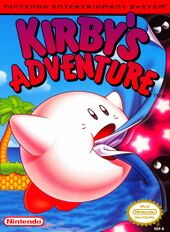
|
Select description: | This was the first game in the Kirby series to include Copy Abilities and minigames. |
| Video description: | In this game, players were introduced to Kirby's famous Copy Abilities. Kirby could get 24 different Copy Abilities in this game, including Sword, Cutter, Hammer, Spark, Stone, and Parasol. This gave players a wide range of new moves to play with and made it possible to play each stage in many ways. Kirby's Adventure was also the first game in the Kirby series to include minigames! | |
| Theme music | Vegetable Valley | |
| Kirby's Pinball Land | ||
|---|---|---|
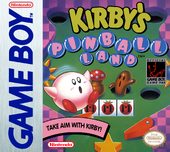
|
Select description: | A game in which ball-shaped Kirby had to reach, and then beat, bosses waiting at the top of exciting pinball stages. |
| Video description: | In this game, the first to veer from Kirby's traditional platforming roots, players helped Kirby explore three challenging pinball worlds by flipping Kirby's bouncy, ball-shaped body. Exciting traps, bonus games, and enemies filled each world. To beat the game, players had to help Kirby defeat several bosses and then win a battle against King Dedede! | |
| Theme music | Kracko Land | |
| In-game blurb |
|---|
|
In 1994...
|
1994
The North American release showcases a golden statue of Lololo & Lalala at the 1994 display, while the Japanese release features Kirby's Dream Course and another manga volume: Kirby of the Stars: The Story of Dedede Who Lives in Pupupu. The player can preview the cover of this volume as well as the first 21 pages.
1995
| In-game blurb |
|---|
|
In 1995...
|
| Kirby's Dream Course | ||
|---|---|---|
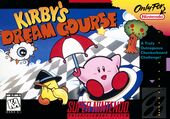
|
Select description: | In this golf-inspired game, ball-shaped Kirby defeated enemies in stages filled with hazards and challenges. |
| Video description: | This golf-inspired game pitted one to two players against eight outlandish courses. To complete a, players had to defeat every enemy on the field and drop ball-shaped Kirby into the cup. Fewer shots meant a higher score. On top of planning each shot's power and trajectory, players had to make smart use of Kirby's 10 Copy Abilities. | |
| Theme music | Mountain Stage | |
| Kirby's Avalanche | ||
|---|---|---|
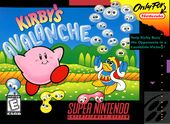
|
Select description: | In this fast-paced puzzle game, Kirby blasted his opponents by strategically stacking color-coded Blobs. |
| Video description: | In this puzzle game, Kirby stacked colorful falling Blobs. By strategically rotating and moving Blobs before they hit the pile, Kirby could destroy them and set off chain reactions. This game included two-player bouts and matches against many familiar faces from the Kirby universe. It's the only Kirby game that wasn't released in Japan. | |
| Theme music | Butter Building | |
| Regional differences | Kirby's Avalanche is not present in the Japanese release of Kirby's Dream Collection due to it never having released in Japan. | |
| Kirby's Dream Land 2 | ||
|---|---|---|
| File:KDL2 Box.jpg | Select description: | This game introduced new Copy Abilities and Kirby's pals Rick, Kine and Coo to the Kirby universe. |
| Video description: | Rick the hamster, Kine the fish, and Coo the owl debuted in this game. These friends not only helped out by carrying Kirby. They also interacted with Copy Abilities in different ways, adding to Kirby's arsenal. | |
| Theme music | Dark Castle | |
1996
| In-game blurb |
|---|
|
In 1996...
|
| Kirby's Block Ball | ||
|---|---|---|

|
Select description: | Once again, Kirby returned to ball form. This time, Kirby had to bounce off paddles and bash his way through blocks. |
| Video description: | Ball-shaped Kirby leapt back into action again! Time time, players bounced Kirby around stages to destroy blocks and defeat enemies. A good sense of timing was essential to getting a high score. Items, power-ups, and Copy Abilities also helped players rack up points. | |
| Theme music | Kirby's Block Ball - Stage 1 theme | |
| Regional differences | In the Japanese release, Kirby's Block Ball is instead displayed at the 1995 stop due to a regional difference in the game's release date. | |
| Kirby Super Star | ||
|---|---|---|
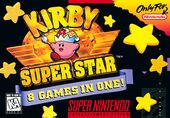
|
Select description: | Kirby Super Star featured eight games and introduced two-player cooperative/competitve play to the Kirby universe. |
| Video description: | Eight games in one? That sounds like fun! This title introduced Copy Ability hats, which changed Kirby's appearance based on which power he was wielding. This game also gave Kirby the ability to transform an equipped Copy Ability into a Helper, which added a new kind of cooperation play to the mix. A Helper could be either controlled by the game's AI or controlled by a second player, and each type of Helper had its own moves. | |
| Theme music | Gourmet Race | |
1997
| In-game blurb |
|---|
|
In 1997... |
| Kirby's Star Stacker | ||
|---|---|---|
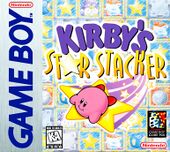
|
Select description: | In this playful puzzler, Kirby and his friends stacked falling stars. With a Game Link cable, two friends could play together. |
| Video description: | Kirby reunited with Rick, Kine, and Coo to unleash their puzzling power! As blocks fell from the sky, Kirby sandwiched stars between his pals and stacked sets together. Much as in Kirby's Avalanche, the key to high scores was chain reactions. | |
| Theme music | Normal | |
| Kirby's Dream Land 3 | ||
|---|---|---|
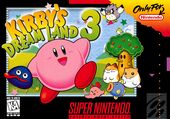
|
Select description: | This game introduced new Copy Abilities and the friends ChuChu, Pitch, and Nago. It also gave Player 2 Gooey to control. |
| Video description: | This game, the last that Nintendo published in the USA for the Super Nintendo Entertainment System, introduced Kirby's friends ChuChu, Pitch, and Nago. Helped by these new allies, Kirby set out to battle an old foe. A second player could control Kirby's pal Gooey and join in the action. | |
| Theme music | Ripple Field 2 | |
| Regional differences | In the Japanese release, Kirby's Dream Land 3 is shown at the 1998 stop due to a regional difference in the game's release date. | |
1998
| In-game blurb |
|---|
|
In 1998...
|
The 1998 stop features a golden statue of a Waddle Dee in place of any official Kirby media.
1999
| In-game blurb |
|---|
|
In 1999...
|
A second statue is found at the 1999 stop, this time of King Dedede wielding his trusty hammer. In the Japanese release of Kirby's Dream Collection, Kirby Star Stacker for the SNES can be found at this stop, as this game was never released outside of Japan.
2000
| In-game blurb |
|---|
|
In 2000...
|
| Kirby 64: The Crystal Shards | ||
|---|---|---|
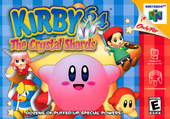
|
Select description: | This game introduced Power Combos to Kirby's arsenal. By combining two Copy Abilities, Kirby could do incredible things. |
| Video description: | This adventure took Kirby to exciting new planets and gave Kirby the ability to mix Copy Abilities together to create impressive Power Combos! Twenty-eight different Power Combos were possible. Each had its own special moves and powers. This is the only Kirby game to allow Kirby to use the inhale ability underwater without Kine's help. | |
| Theme music | Training | |
2001
| In-game blurb |
|---|
|
In 2001...
|
| Kirby Tilt 'n' Tumble | ||
|---|---|---|

|
Select description: | This game featured innovative controls that let players move Kirby by tilting and shaking their Game Boy Color systems. |
| Video description: | This was the first game in the Kirby series to make use of motion controls. These controls were because the game pak itself contained a tiny motion-sensing device! This enabled a player to move like Kirby by tilting his or her Game Boy Color system. Five minigames that also made use of these motion controls accompanied the main game. | |
| Theme music | Simple Stage | |
| Regional differences | In the Japanese release, Kirby Tilt 'n' Tumble is shown at the 2000 stop due to a regional difference in the game's release date. | |
2002
| In-game blurb |
|---|
|
In 2002...
|
| Kirby: Nightmare in Dream Land | ||
|---|---|---|

|
Select description: | In this colorful remake of Kirby's Adventure, up to four friends could play cooperatively of face off in multiplayer minigames. |
| Video description: | This remake of Kirby's Adventure included many new features, including the ability to play with up to three friends! Each player controlled his or her own Kirby, and each Kirby could grab his own separate Copy Abilities. | |
| Theme music | Vs Dedede | |
| Kirby: Right Back At Ya! | ||
|---|---|---|

|
Select description: | This 100-episode animated TV series was first broadcast in the USA in 2002. It's been released in many other countries as well. |
| Video description: | N/A | |
| Theme music | Kirby: Right Back at Ya! theme | |
| Regional differences | In the Japanese release, Kirby: Right Back At Ya! is shown at the 2001 stop due to a regional difference in the anime's release date. The episodes included are the same, but use their respective dubbed versions, and naturally include the differences made when dubbing those episodes. Moreover, in the Japanese version, the Stadium theme from Kirby Air Ride plays on the sub-menu rather than the Kirby: Right Back At Ya! theme. | |
2003
| In-game blurb |
|---|
|
In 2003...
|
| Kirby Air Ride | ||
|---|---|---|

|
Select description: | The first Kirby racing game! The Air Ride machines' controls may have been simple, but mastering them took skill and practice. |
| Video description: | Kirby Air Ride included many different high-speed racing modes. The controls for this game may have been simple, but becoming a top-scoring Air Ride racer took lots of practice and strategy. Players who were good at handling their Air Ride machines and Kirby's Copy Abilities could look forward to unlocking special characters. | |
| Theme music | The Legendary Air Ride Machine | |
2004
| In-game blurb |
|---|
|
In 2004...
|
| Kirby and the Amazing Mirror | ||
|---|---|---|
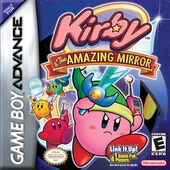
|
Select description: | In this game, Kirby was split into four differently colored Kirbys. Luckily, he could call them for help with his trusty cell phone. |
| Video description: | In this game, players didn't have to defeat stages in a specific, preset order. Instead, they were able to freely explore the game's vast new world and choose their own paths to victory. Along the way, Kirby could call his yellow, red, and green Kirby buddies for help by using his trusty cell phone. Kirby could also use new powers. One of them, Smash, was an incredible combat ability that let Kirby unleash his Super Smash Bros. moves. | |
| Theme music | Rainbow Route (Area 1) | |
2005
| In-game blurb |
|---|
|
In 2005...
|
| Kirby: Canvas Curse | ||
|---|---|---|

|
Select description: | Kirby returned to ball form, this time to roll along a rainbow line drawn by the player's stylus in a brand-new adventure game. |
| Video description: | In this unique adventure, Kirby followed the rainbow line that the player drew on the Touch Screen with his or her stylus. The rainbow line could also be used to shield Kirby from attacks, but Kirby wasn't the only star of this game. Other familiar characters made appearances as playable characters too! | |
| Theme music | Paint Panic theme | |
2006
| In-game blurb |
|---|
|
In 2006...
|
| Kirby: Squeak Squad | ||
|---|---|---|
| File:USCover KSS.jpg | Select description: | "This game introduced the Copy Palette, which allowed items and Copy Abilities to be saved and mixed together." |
| Video description: | In this game, Kirby chased down a gang of mice who'd stolen a precious, delicious treasure. Along the way, Kirby found many other treasures, including star seals and ability scrolls. Using the Copy Palette, Kirby could save items and Copy Abilities and mix them together. This new feature introduced players to a whole new level of strategy. | |
| Theme music | Squeak Squad Appears! | |
| Regional differences | In the Japanese release, the 2006 stop includes yet another volume of an official Kirby manga series: Kirby of the Stars! Moretsu Pupupu Hour!. The player is able to preview the cover as well as the first 17 pages. | |
2007
| In-game blurb |
|---|
|
In 2007...
|
A golden statue of Meta Knight is shown at the 2007 stop in place of any official Kirby media. In the Japanese release of Kirby's Dream Collection, the 2007 stop includes an entry detailing Kirby arcade games.
2008
| In-game blurb |
|---|
|
In 2008...
|
| Kirby Super Star Ultra | ||
|---|---|---|
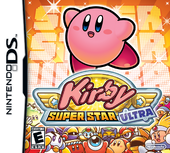
|
Select description: | This remake of Kirby Super Star included a new story, seven new minigames, multiplayer support, and updated graphics. |
| Video description: | This remake of the beloved Kirby title Kirby Super Star included the original games with updated graphics, a new storyline, and several new minigames. Among these new games were stylus-controlled minigames. Many of this title's games allowed several players to play together. Beating certain games unlocked special bonus content, including a hilarious blooper reel! | |
| Theme music | Masked Dedede's Theme | |
2009
| In-game blurb |
|---|
|
In 2009...
|
The 2009 stop features a golden statue of Magolor in place of any official Kirby media. In the Japanese release of Kirby's Dream Collection, an entry detailing Kirby 3D can be found at this stop.
2010
| In-game blurb |
|---|
|
In 2010...
|
| Kirby's Epic Yarn | ||
|---|---|---|

|
Select description: | This game sent Kirby to a world made of fabric, where he was transformed into yarn and gained amazing new powers. |
| Video description: | Sucked into a world made of cloth by the evil sorcerer Yin-Yarn, Kirby discovered he'd been turned into yarn! In this form, Kirby couldn't inhale or use Copy Abilities, but he gained new powers and could change his shape in amazing ways. With the help of Prince Fluff, the heroic prince of Patch Land, Kirby set out to defeat Yin-Yarn. Along the way, he helped the residents of Patch Land as a friendly neighbor in Apartment 101 of Dom Woole's apartment building! | |
| Theme music | Dream Land (World 7 Map) | |
2011
| In-game blurb |
|---|
|
In 2011...
|
| Kirby Mass Attack | ||
|---|---|---|
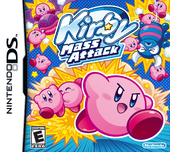
|
Select description: | This game really embraced the concept 'the more the merrier.' Using the stylus, up to 10 Kirbys could be controlled at once. |
| Video description: | In this game, poor Kirby was split into 10 weaker copies of himself by the villainous Necrodeus. Using the stylus, players guided these mini Kirbys on an amazing adventure to restore Kirby to his former self. If Kirbys were lost along the way, collecting fruit restored them. On top of this main game, seven minigames added to the action. | |
| Theme music | Kirby Mass Attack - Main Theme | |
| Kirby's Return to Dream Land | ||
|---|---|---|
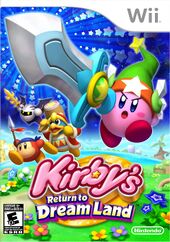
|
Select description: | This game introduced incredible Super Abilities and cooperative multiplayer that other players could join and leave at will. |
| Video description: | When a mysterious traveler crash-landed on Planet Popstar, Kirby and his friends rushed to his aid, and an amazing adventure began! This game featured extra-powerful Copy Abilities called Super Abilities, which gave Kirby incredible new attacks. Kirby's inhale ability also got powered up in this game. Additional players could join and leave the game at will. Moves like Piggyback and Team Attack let players help each other through tough spots. This game also included minigames that could be unlocked as the story progressed. | |
| Theme music | Super Ability | |
2012
| In-game blurb |
|---|
|
In 2012... |
| Kirby's Dream Collection Special Edition | ||
|---|---|---|

|
Select description: | A celebration of all the fun we've had over Kirby's first two decades. Here's to many more! |
| Video description: | N/A | |
| Theme music | Magolor, the Distant Traveler | |
| Regional differences | Unlike the Japanese release, the North American version includes a the performance video for "Gourmet Race to Green Greens ~ Chamber Music", which plays for around three and a half minutes. | |
Trivia
- Most of the tall pillars in the hallway are topped with golden statues of Kirby. However, statues of Rick, Kine, Coo and a Waddle Dee also appear on the pillars, which are randomly placed every time the mode is loaded.
- Since the release of Kirby's Dream Collection, many of the world records mentioned have been broken:
- The record for largest lollipop, mentioned at the 1994 stop, was broken exactly one day before the game's release in Japan (July 18th, 2012), with the new and current record weighing in at 7,003 pounds (3176.5 kilograms). Notably, the record is mislabeled on Guinness as 3176.5 metric tons.[1]
- The record for youngest person to climb Mt. Everest, mentioned at the 2001 stop, now belongs to Jordan Romero, who achieved the feat at 13 years old in 2010.[2]
- Cal Ripken Jr.'s record, mentioned at the 1995 stop, now stands at 2,632 games and is still unbeaten.[3]
- The demo caption for Kirby's Dream Course implies that the eight main courses can be played with one or two players when, in fact, said courses are single-player only, while the 2P game has four distinct courses to itself.
- Despite what the select description for Kirby's Dream Land 2 implies, no new standard Copy Abilities were added in this game. Instead, several ability combos and the Rainbow Sword were introduced.
- The Power Combo count mentioned in the demo caption for Kirby 64: The Crystal Shards does not include Ribbon's Crystal.
External links
- The Cutting Room Floor - Kirby's Dream Collection: Special Edition (includes translations of the trivia boxes in the Japanese release)
References
Names in other languages
| Language | Name | Meaning |
|---|---|---|
| Japanese | 星のカービィ ヒストリー Hoshi no Kābī Hisutorī |
Kirby of the Stars History |
